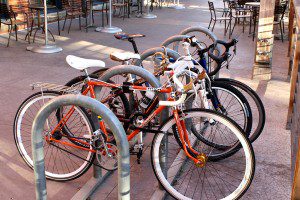A How-To Guide on Installing a Bike Rack in Philadelphia

By Will Fraser, Sustainable Transportation Outreach Coordinator
Bicycle parking in Philadelphia is in high demand. Philadelphia boasts one of the nation’s highest percentages of bicycle commuters, growing 250% from 2005 to 2013. Seventy percent of cyclists say they would bike more if secure bicycle parking was available. As a business owner, the small investment of installing a bicycle rack makes sense – a business can even change their Yelp profile to show they offer bicycle parking! Installing a bicycle rack goes beyond increasing foot traffic: it strengthens businesses’ relationships with their local community, promotes healthy, active living, motivates the use of non-polluting transportation, and encourages people to patronize businesses that regard bicycles as an important part of Philadelphia’s transportation infrastructure. Below is a short guide outlining how to install a bicycle rack in Philadelphia.

1. Read through the entire Street Department’s Bicycle Rack Application and complete the permit application. This application includes the Philadelphia’s Bicycle Rack Installation Guide which contains all of the information needed to submit a request to the Streets Department. Completing the initial bike rack application requires both the business owner and building owner signatures.
[Tip] To save time, check the City’s minimum requirements for installation (pages 2-9), e.g.: 30 feet from a bus stop or 4 feet from a fire hydrant, to ensure there is enough storefront space for a bicycle rack.
2. Choose a type of bicycle rack that fits the business’ needs. The best bike rack will enable a bicycle to be secured to a rack by both wheels and the frame. Most “standard-U” or “staple” bicycle racks allow two bicycles to be securely locked to the rack and come in a variety of colors and styles.
[Tip] Make sure that the bicycle rack meets the maximum bicycle rack dimensions allowed by the City, 42” long x 42” tall x 8”wide. The bicycle rack should be purchased only after all permits have been approved by the city.
3. The bike rack application also calls for an architectural rendering and photographs of the proposed bicycle rack location. To create a rendering, contact a landscape architect to draw up a simple plan of your storefront location. Business owners that cannot afford this and do not mind waiting 90 days can call or email Will Fraser, who can assist with this process. He can be reached at (215) 567- 4004 ext: 123 or wfraser@cleanair.org.
[Tip] Make sure renderings include adjacent properties, obstructions in the sidewalk, widths of all doors; and position bike racks 30 inches from the curb edge.
4. Install the bike rack. Depending on the size of the rack and the type of substrate, there are two different ways to install a bicycle rack. Bicycle racks installed on concrete require minimum  3/8” thick and 3” long anchors. Bicycle racks installed on brick, cobblestone, grass or asphalt must be installed on a poured concrete pad at least 24” in width x 30” in length x 4” in depth, and bolted into place as explained above.
3/8” thick and 3” long anchors. Bicycle racks installed on brick, cobblestone, grass or asphalt must be installed on a poured concrete pad at least 24” in width x 30” in length x 4” in depth, and bolted into place as explained above.
[Tip] When installing on an uneven surfaces use rubber washers to make sure that the rack is perpendicular to the ground.
Read more about how Clean Air Council can help your business install a bike rack.
If you would like more information on bike rack installation, please contact Will Fraser, Sustainable Transportation Outreach Coordinator, by calling 215-567-4004 ext. 123 or emailing wfraser@cleanair.org.


